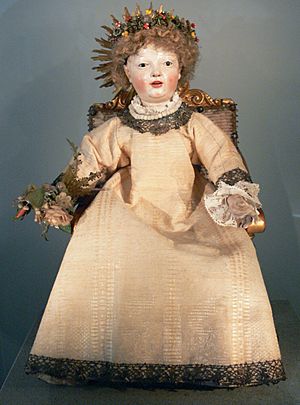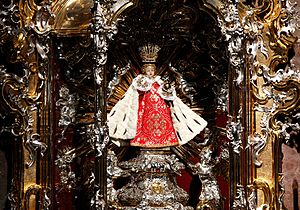Christkind facts for kids
The Christkind, also known as Christkindl, is a special figure who brings Christmas gifts. This tradition is popular in many countries. You'll find it in places like Austria, Switzerland, parts of Germany, the Czech Republic, Croatia, and even some areas of Latin America. The name "Christkind" means "Christ Child." In different languages, it has different names, like Menino Jesus ("Jesus Boy") in Portuguese or Ježíšek ("Little Jesus") in Czech.
Contents
The Story of Christkind

How the Tradition Started
The idea of the Christkind as a gift-giver became popular in the 1500s and 1600s. This was during a time called the Protestant Reformation. Martin Luther, a key figure in this movement, wanted to focus on Jesus as the reason for Christmas. So, many Protestants started having the Christ Child bring gifts instead of Saint Nicholas. Gifts were then given on Christmas Eve instead of December 6.
Later, in the 1800s, the Christkind tradition also spread to Catholic areas of Germany. Today, the Christkindl is still the main gift-bringer in many Catholic countries in Latin America.
What Christkind Looks Like
The Christkind is often shown as a child with blond hair and angelic wings. Martin Luther wanted it to remind people of Jesus as a baby. Sometimes, people see the Christ Child as a special angel who brings presents. This angel might even appear in parades with a statue of baby Jesus. Over time, some stories said the Christkind would deliver gifts with Saint Nicholas.
How Gifts Are Given
Children never actually see the Christkind. Parents tell them that if they try to peek, the Christkind won't come with presents. On Christmas Eve, families go into the living room where the Christmas tree is set up. This is when they open presents, a time called the Bescherung. Parents often say they think the Christkind has just left. In some families, a small bell rings to announce that the Christkind has gone. An adult secretly rings the bell.
Christkind Today
Since the 1990s, the Christkind has faced competition from Santa Claus. This is because the American version of Santa Claus is often used in advertising. However, many traditional Catholics believe that the Christkind helps people remember the true meaning of Christmas.
The names Christkindl or Christkindel are smaller versions of Christkind. You can also find Christkind and Belsnickel traditions among people of German descent in Argentina. A famous Christkind is at the Christkindlesmarkt in Nuremberg, Germany. A young woman is chosen every two years to play this role.
Christkindl is also part of the city of Steyr in Austria. The city was named after a wax statue of Christkind in a local church, which people believed had special powers.
Ježíšek in the Czech Republic

Ježíšek is the Czech name for the Christkind figure at Christmas. There isn't one exact way to describe Ježíšek. Some people imagine Ježíšek as a baby, a toddler, or even a young boy. Others think of Ježíšek as more of an idea than a person.
Ježíšek's Traditions
According to tradition, Ježíšek appears on Christmas Eve. In some families, people say Ježíšek brings both the Christmas tree and the gifts. Adults secretly help with this. In other families, everyone helps decorate the Christmas tree together. Christmas gifts are delivered and opened on Christmas Eve (December 24).
Czech people have followed the tradition of Ježíšek for over 400 years. This is partly because many people were Catholic during that time. Martin Luther first used the term in the 1500s. He wanted to give a different name for the gift-giver than Saint Nicholas. Even today, many people in the Czech Republic believe in Ježíšek.
La Christine in Acadiana
La Christine is the Cajun French name for a traditional folk figure. You might also hear it called La Christiane or La Crisquine. This figure traditionally brought "fruits, homemade candies, and small gifts" on New Year's Eve. The name "La Christine" comes from "Christkind." The tradition likely came to the area from German-speaking settlers from Switzerland.
In some families, La Christine would visit a week after Papa Noël brought Christmas gifts. Some even described her as "Santa Claus' wife." In other families, "La Christine" was just another name for Santa Claus.
See also
 In Spanish: Christkind para niños
In Spanish: Christkind para niños
- Kris Kringle, an Americanized way to say and spell Christkindl
- Christkindl Markt, a traditional holiday market in Austria, Germany, and Eastern France
- List of Christmas and winter gift-bringers by country


